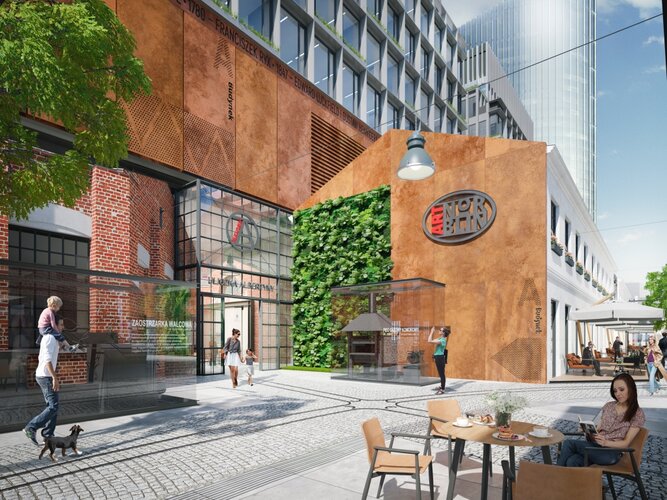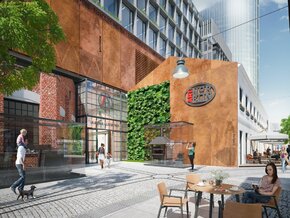Charming plane trees with spreading crowns, elliptical hornbeams, crop plants, decorative shrubs and vines that correspond with historical buildings – all these species will appear in the planned green landscape on the site of the revitalized former Norblin factory. The greenery is created by the landscaping company RS Architektura Krajobrazu. There will be also beehives on the roofs of buildings and facilities for urban birds.
The revitalized former Norblin factory will become a part of the dynamically developing Wola district, a new heart of the city, vibrant with culture, entertainment and sports. Over two hectares of land at the intersection of Żelazna and Prosta streets will be transformed into a natural extension of the open public space, full of urban greenery. The streets of the complex will be filled with lots of plants. Greenery will also appear on the walls and terraces of buildings, as well as over the heads of visitors, creating unique decorations, changing with the seasons. The concept of greenery on the site of the former Norblin factory has been created by the landscaping company RS Architektura Krajobrazu. The company specializes in green areas integrated with architecture and has broad experience gained during working on many large-scale projects, including the Vistula Boulevards, the project of filling Świętokrzyska Street with greenery, Hala Koszyki or Business Garden in Warsaw. In addition to this, the company will cooperate with the investors from the area in order to design a harmonious and well thought-out public pedestrian route, which will be full of attractive urban furniture and greenery. It will stand out among the other such urban spaces in Warsaw due to its size and quality, and due to combining three different investments with complementary functions in the area – including offices, services and restaurants.
– Developers are more and more often cooperating in order to create a common, combined space. The times of separating oneself from the city and neighbors with fences fortunately are over and the coherence of neighbouring projects, also in the aspect of space planning, becomes an added value for the people who use them – says Kinga Nowakowska, Operational Director and Member of the Management Board of Capital Park Group. – The revitalized Norblin factory will be an exceptional place, with a soul and a unique atmosphere, created, among other factors, by greenery planted there: trees, lush bushes, perennials, as well as vegetables and herbs carefully integrated into the whole project. As the investor, we had very clear aims regarding greenery in the area of our investment, which is why we employed a company with extensive experience in this field. Vegetation is also of great importance to our ecosystem and quality of life in general, as it absorbs urban smog to a large extent, and dealing with smog is one of the most important challenges that we are currently facing – Kinga Nowakowska adds.
Over a dozen trees, reaching 5 to 10 meters in height, will be planted in the area of the former Norblin factory. Due to the presence of the underground parking lot, the trees will be planted in special pots fixed into the parking lot ceiling. Strolling through the paths of the post-industrial space, one can admire one of the most beautiful decorative trees – hybrid plane trees. What is important, these trees, thanks to their original, chandelier-shaped, spreading crowns, will perfectly fit into the historical context of this place, and they will also cast shade on the inner passage. The second species of trees that will appear in the revitalized factory is a hornbeam with its characteristic, elliptical shape. This tree species creates a kind of leaf cover that perfectly protects from the dust and suppresses noise. Importantly, the hornbeam will look charming not only in the summer, as it does not lose its leaves when they dry, so they remain on the tree throughout the year.
The greenery planted next to the entrances to the complex from the side of Prosta Street will be composed mostly of vines, creating the original decoration of the facades. The plants located between the buildings and let over visitors’ heads will create a unique portal to the former factory of Norblin. The composition of climbing plants in the revitalized space will include, among other species, grapevine (non-fruiting variety) and aristolochia, known for large, decorative leaves. The vines will be spread on the walls of buildings using invisible fasteners and a system of cords dedicated for this type of plants.
On the terraces of buildings, there will be pots with various shrubs and vines. Lots of beautiful flowers will appear in the area too, including such plants, as cherry laurel with numerous white flowers, panicled hydrangea with white and pink inflorescences and fragrant mock-orange. Decorative perennials will be planted among the shrubs, complementing the whole composition. There will be ferns with decorative leaves and plantain lilies, and also white-blossoming perennials, such as chestnut-leaved rodgersia, Wherry’s foamflower and Chinese astilbe. In addition to that, there will be a few other mixes of perennials and shrubs, composed of species chosen particularly for a given terrace, taking into account its location and exposition. The plants will blossom at different times of the year, so from early spring to late summer the factory area will be enlivened with lots of various flowers.
– The most important goal of our project is to incorporate the planned greenery into the historical and industrial character of the place. This applies in particular to the passage area surrounded by historic buildings. We have decided to plant there hybrid plane trees with spreading, chandelier-shaped crowns, which will be the only such trees in Warsaw of such form and scale. This species was chosen for a purpose – it is a strong and resistant tree, well responding to pruning, broadly used in the nineteenth-century in Western European cities, like Paris, Brussels and Geneva –explains Patryk Zaręba from RS Architektura Krajobrazu. – All the remaining elements of the project, including the vines covering the walls of historic and contemporary buildings, trees planted in the pots located in the car park ceilings, pots with various mixes of flower species, ensuring dynamics and seasonal variability, will be characterized by conscious references to the heritage and character of this unique place –he adds.
In the area of BioBazar, which will return to the revitalized factory, there will be specially designed, galvanized flower pots intended for the cultivation of decorative and crop plants. The flower pots – each with a size of one sq.m. – will have a height of 45 and 75 cm. The species that will be planted in them include purple willow, feather grass, fragrant purple giant hyssop and European columbine. There will also be a number of crop plants, such as herbs or vegetables, fitting into the concept of an ecological market. The company Capital Park cares about animals as well, and because of this will build also bird feeders and nesting boxes in the green areas of the factory. Another pro-ecological solution, already functioning in the other buildings of this investor – the urban beehives – will be installed on the roofs of the factory.
Kontakt dla mediów






